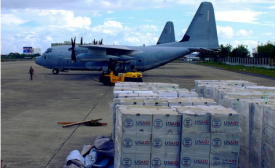typhoon haiyan
On November 8, 2013, Super Typhoon Haiyan ravished the Philippine archipelago. With 195 MPH winds and gusts of up to 230 MPH, the typhoon killed an estimated 4,000 people and displaced another 670,000. Across the southern part of the Philippines and especially in Tacloban, the city most affected by the typhoon, the scene is apocalyptic.

APDS Blogger: Shannon Haugh
Emergency relief provided by U.S. troops in areas devastated by typhoon Haiyan in the central Philippines makes a strong case for the two allies to clinch a new military accord, Manila's foreign minister said on Monday. The Philippines and the United States have been negotiating a new security agreement allowing wider and more prolonged access for the U.S. military at bases and other facilities in its former colony. It also provides for storage of equipment and supplies for humanitarian and maritime operations.
Just as in Pakistan after devastating floods and earthquakes, Thailand after the tsunami and the worst flood in a century, and Haiti after an earthquake leveled its major city, America's military is once again doing a masterful job of staging relief supplies into an area devastated by a catastrophic natural disaster. In the Philippine islands where barely a tree is left standing and as many as 10,000 are feared dead, U.S. soldiers are on the ground.
The immediate aftermath of a natural disaster, such as the typhoon that devastated part of the Philippines on Nov. 8, can bring out the best in the global community. Already we are seeing the world’s governments and citizens responding generously to appeals for aid, reaffirming our shared humanity. The challenge is to ensure that this generosity reaches the people who desperately need it. Relief and reconstruction efforts in the Philippines have much to learn from previous mega-disasters, including, most recently, the massive earthquake in Haiti in 2010.
In the wake of the devastating Typhoon Haiyan, international aid is flowing to the Philippines. The United Nations released $25 million from an emergency fund and the United States pledged $20 million in immediate relief. But, for the moment at least, precious little assistance is coming from the region's behemoth. The Chinese authorities announced a paltry $100,000 in humanitarian aid (along with another $100,000 via the Red Cross Society of China).
The U.S. has promised $20 million in aid for victims of Supertyphoon Haiyan in the Philippines and has mobilized an aircraft carrier for the relief effort. Britain is also sending a warship and has pledged $16 million. The Vatican is dispatching $4 million, Japan $10 million and New Zealand $1.7 million. And China, the world’s most populous nation and second largest economy? It’s handing over $100,000.
Super Typhoon Haiyan, one of the most powerful storms in recorded history, has affected over 4 million people and is estimated to have killed more than 10,000, according to officials in the Philippines. Some coastal cities, including Tacloban whose population is about 220,000, were almost completely flattened, which means that aid efforts around the country remain severely hindered.







